Prone to flooding and experiencing rapid urban growth, Thailand is particularly vulnerable to the first effects of climate change. On the Rangsit campus of Thammasat University, an ingenious rooftop is an example of a multifaceted solution that addresses challenges of climate change while providing significant other benefits at the same time.
The Rangsit campus sits on land that, a century ago, was part of a vast area of 772 square miles containing paddy fields and swamps, which one former king envisioned as the most productive rice-farming area in the world. A habitat for many kinds of wildlife, such as wild elephants and a now extinct medium-sized deer with elaborate antlers, the area rapidly changed from fields to developments as urbanization covered over the rice paddies and pushed out the fauna that lived within them.
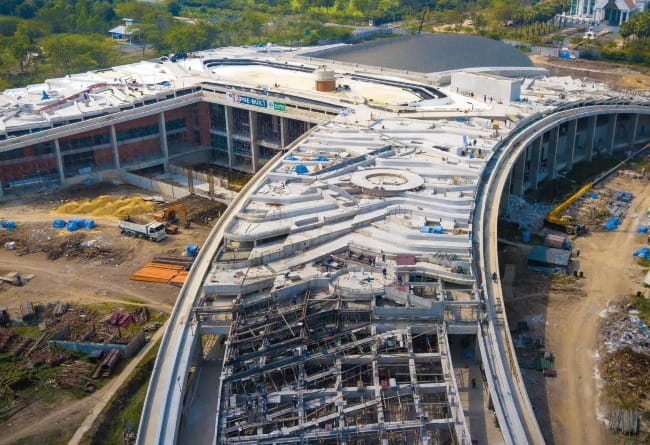
When the Puey Ungphakorn Centenary Hall on the Rangsit campus was originally being planned, the original idea, according to architect Kotchakorn Voraakhom, was a conventional roof, but she persuaded the architecture and engineering teams to collaborate with her on a more radical and exciting idea—expanding an already-planned park so that instead of only being in the front of the building, it would go up and over the building as well, creating a link from the park to a rooftop green space. The result is the largest organic rooftop farm in Asia—a 1.73-acre farm that, among other benefits, provides food, water retention, flood control, public space, solar energy, work opportunities and classroom curriculum.
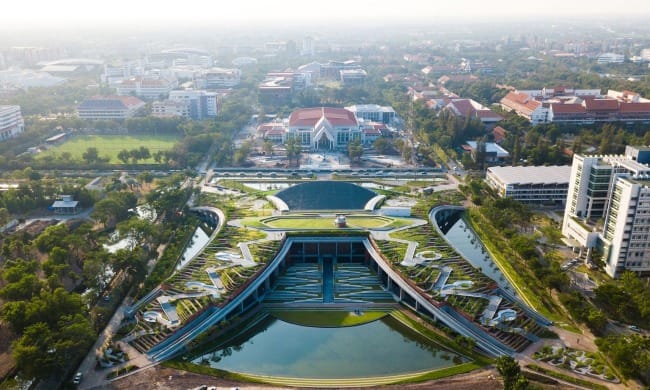
Learning from Tradition
The farm's design derives inspiration from traditional rice terraces of northern Thailand. Visually, it is a homage to the area's history, but the terracing serves practical purposes as well—as might be expected when modern designers attend to and learn from local knowledge and wisdom acquired over many centuries.
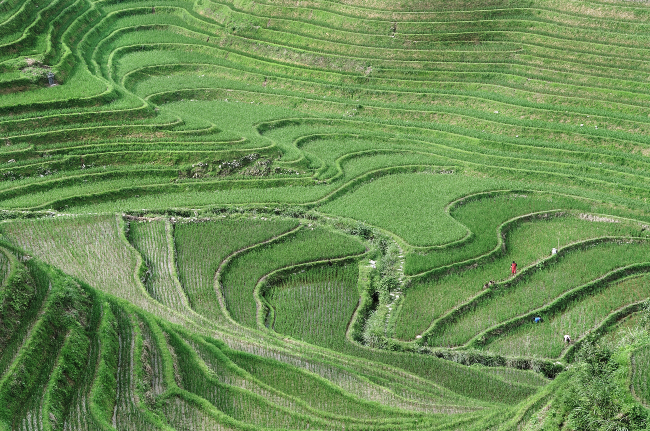
The terrace design allows the heavy seasonal rainfall to flow down the hillside through the many layers, where, at each layer, it is absorbed or slowed down (up to 20 times more than a normal concrete rooftop) and is also filtered and cleaned via the multiple levels of plants and soil.
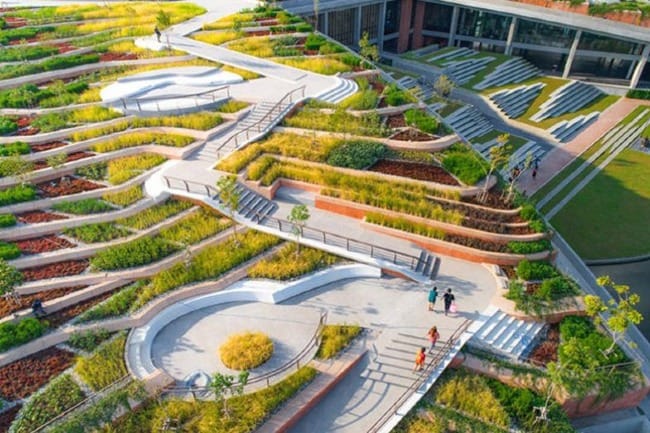
After it has zigzagged down the slopes, whatever has not been absorbed is directed into one of the four huge retention ponds at the bottom of the hillside. Here, the naturally filtered water is either released for residential water use, is sent into marine ecosystems or, as needed, is pumped to the top of the rooftop to irrigate the rooftop farm itself.
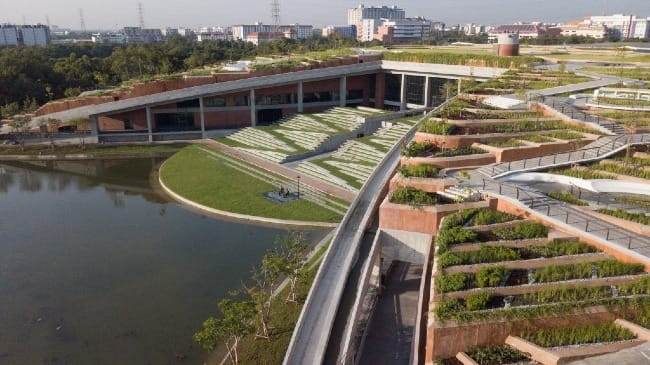
The Harvest
The Thammasat University Rooftop Farm (TURF) is an organic farm hosting a large variety of crops such as drought tolerant rice, many indigenous vegetables and herbs (red and green oak-leaf lettuce, Thai eggplant, green roselle, Thai red pepper, and dill), Jamaican Cherry, White Cheesewood, Camphor, Red Sandalwood, Ceylon Oak trees, azaleas, lemongrass, holy basil, amaranth, and okra. It can produce 20 tons of organic food within a growing season—enough for 80,000 meals in the campus cafeterias. In addition to providing healthy produce, the use of this (very) local food greatly reduces the cost and energy required for food transportation. The community around the university is also invited to participate in the bounty that the farm provides as they participate in the growing and harvesting.
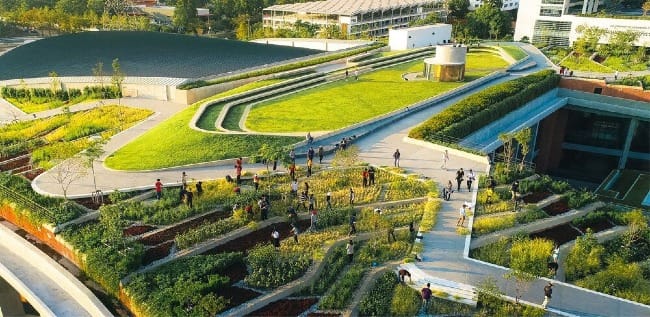
From the cafeterias, food scraps are composted and returned to the roof farm, resulting in a sustainable food cycle and, since the garden is organic, pesticide pollution is nonexistent. By growing native plants, the farm restores biodiversity and attracts bird and insect pollinators, providing habitat for a diverse set of creatures.
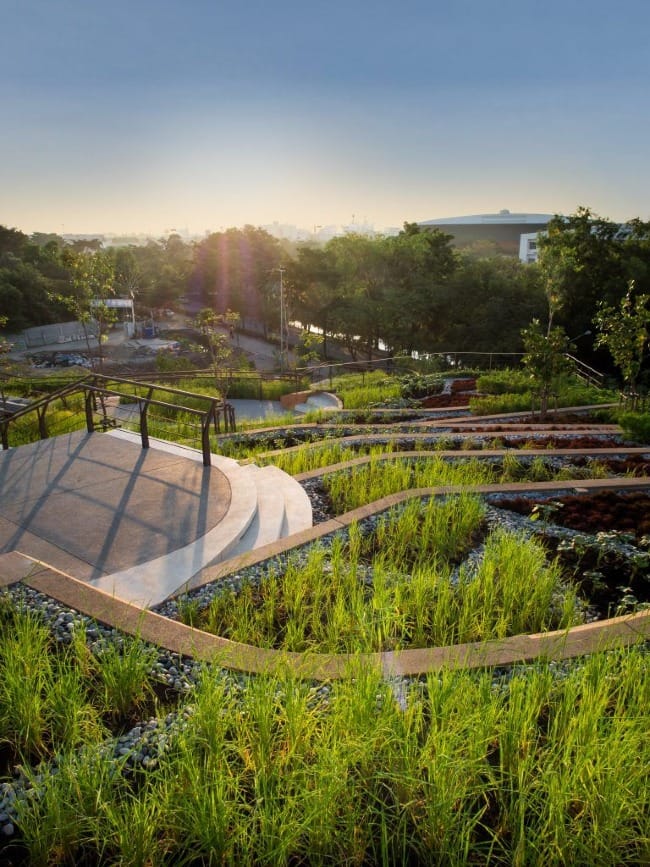
What the Farm Teaches
The rooftop farm is also used to provide learning opportunities for the campus and local population. Twelves spaces within the farming terraces function as outdoor classrooms and various disciplines within the campus use the farm to teach about such diverse subjects as climate change, energy, ecological and human rights, food, the waste industry, water management, financial economy, governance and lowering a person's carbon footprint.
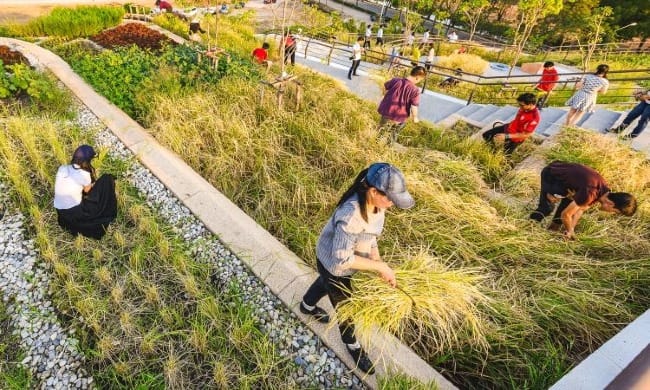
Although Thailand has a long agricultural heritage, many urbanites know little of that heritage. The rooftop farm helps reconnect students and community members to their history and educates them about sustainable, organic growing practices. Students and nearby residents volunteer on the roof, learning how to plant and harvest, with access to workshops on agriculture, nutrition, and permaculture, which are part into the university’s overall sustainability curriculum and emphasis.
“Students and community members are invited to participate in seasonal seeding, harvesting, and so on,” says Voraakhom. “Farming is a crucial part of our country’s heritage. The urban farm is training a new generation of organic farmers with real-world skills. It also fosters a sense of community.”
In addition to the farm being open to the public, the space includes a viewing platform and an amphitheater at the apex of the structure which are used both by university members and members of the community.
Source of Energy
On the South side of the structure, beside the sky amphitheater, 38373.34 square feet (3,565 square meters) of solar panels, capable of producing up to 500,000 watts per hour, have been installed. The energy produced runs the water pumps that bring up water from the retaining ponds to irrigate the crops as well as powering multiple university buildings. In addition, the roof provides insulation from heat and the retaining ponds acts as a natural air conditioner for the air entering the building. “When the wind blows over the water in the ponds, it creates a microclimate that also cools the atmosphere around the building, helping to reverse the urban heat island effect, says Voraakhom.
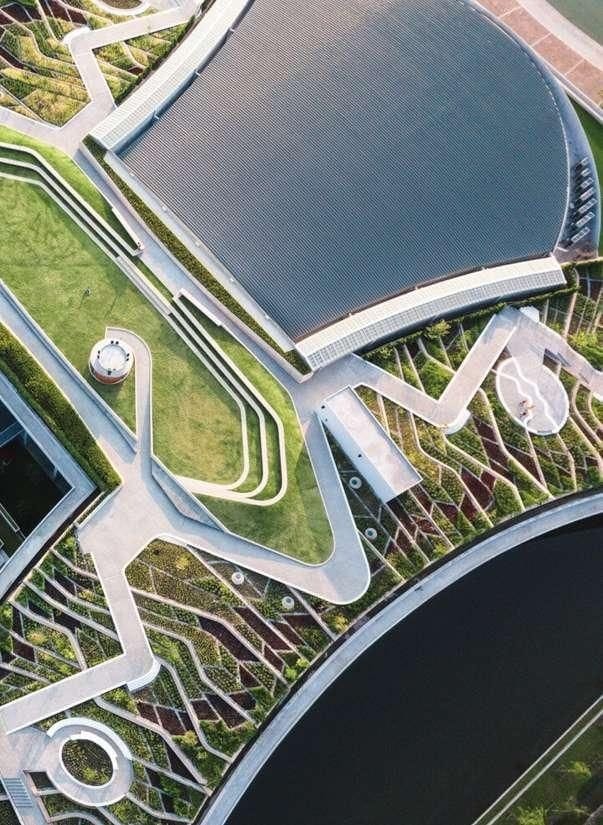
Dreaming Big
The scale of the rooftop project is amazing and yet even that is just part of a larger ongoing effort to make Thammasat University more sustainable. The university is working hard to consistently incorporate the UN Sustainable Development Goals (SDGs) that UN member states have agreed to use as a framework for successful development, to promote prosperity while protecting the planet.
One thing that can be learned from the example of Thammasat University is the value of taking a wider view of possible solutions when exploring a problem. By investing more, taking longer, and thinking about a broader range of possibilities, a mere rooftop has become an asset that goes far beyond solely providing shelter from weather.
It makes me wonder what solutions we can come up with in our own personal situations that don't just fix one thing, but instead, accomplish several things at once. What might happen if we step back and look at the connection between things in creation, rather than seeing the parts as separate, non-related entities? What can we learn from the knowledge that has been acquired by others over centuries of living on the land? What can happen if we dream big and think outside the box? What might happen if we consistently take into account the overall design of this creation when we make decisions concerning our own localities and lives?
Louise
I would love to hear from you at info@circlewood.online or through the comment section below.
